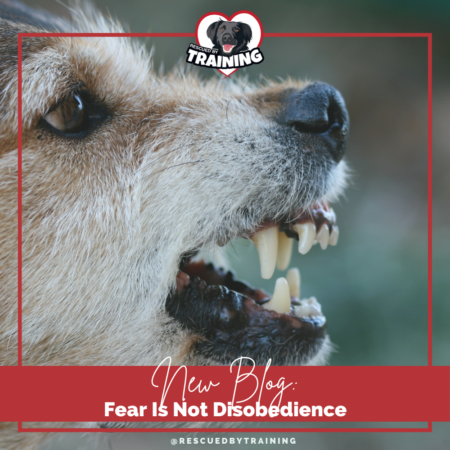FEAR IS NOT DISOBEDIENCE.
Yes, I’m screaming. If I could reach my rooftop I’d scream this from there. As someone who specializes in fear and aggression cases, so often I come across clients who are frustrated with their dog “not listening” in certain situations or who are “being disobedient.” Of course some people may not know how to identify fearful body language in dogs (download my free Dog Communication handout here) so they focus on the fact that the dog isn’t doing what they’d like them to. Or the dog is barking, lunging, growling, freezing, pancaking or any other number of behaviors that people find undesirable.
Even if someone recognizes a dog is uncomfortable they think they just need to somehow “show” the dog the thing isn’t scary and they inadvertently force to dog closer to the very thing the dog is trying to avoid. Not only does this not help teach the dog the thing isn’t scary, it might actually make it worse or teach the dog that their person forces them into scary situations. Dogs don’t learn by imitation. This isn’t how dogs learn. (Download my How Dogs Learn handout here.)
We routinely put dogs into situations we think they can handle or “should” be able to handle and they can’t (and they shouldn’t be expected to). We ask dogs to tolerate lots of weird things and just roll with it. We bring them to busy “dog friendly” events where there’s way too many people and dogs. We introduce them to unfamiliar people or children. We poke and prod them “because we have to.” We pick them up without consent. And then we get upset when they bark, lunge, don’t greet strangers, growl or do other undesirable things as a reaction. And then many people will yell or attempt to “correct” the dog for their misbehavior in these scary situations.
Dogs don’t need corrections, they need compassion. Not just fearful dogs but all dogs. There is never a reason to correct a dog. When corrections are given, they are scaring, startling or otherwise attempting to interrupt behavior. It’s not teaching the dog anything other than potentially to be afraid of us. So what do we do instead? We as guardians need to do a better job at understanding the motivation behind why dogs do what they do and we need to do a much better job at reading body language, managing their environments and teaching them alternate behaviors when they do something we would prefer them not to. All of these things are on US, not the dog.
 And remember, No, Is Not A Behavior. And, there is a big difference between Behavior Suppression Versus Behavior Modification. If you need some free management help, you can download my free Top 6 Management Strategies here.
And remember, No, Is Not A Behavior. And, there is a big difference between Behavior Suppression Versus Behavior Modification. If you need some free management help, you can download my free Top 6 Management Strategies here.
Schedule your one on one session here! Slots are filling up so book today.
Be sure to sign up for my free weekly newsletter so you don’t miss out on free tips, videos, personal stories, client successes and more!
Happy training!
![]()




